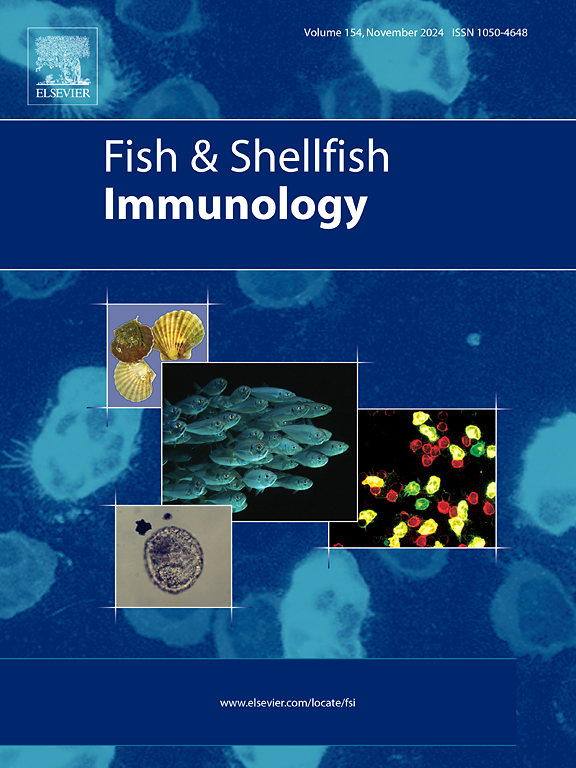Transcriptome analysis reveals the mechanism of black rockfish (Sebastes schlegelii) macrophages respond to Edwardsiella piscicida infection in vivo
IF 4.1
2区 农林科学
Q1 FISHERIES
引用次数: 0
Abstract
Sebastes schlegelii is an economically significant marine fish that faces serious threats from various pathogens. Edwardsiella piscicida is a pathogenic bacterium that primarily affects fish, including S. schlegelii, leading to severe disease. Although numerous reports have documented the transcriptome sequencing of various fish tissues in response to E. piscicida infection, studies focusing on specific cells remain scarce. In this study, S. schlegelii were infected by intraperitoneal injection of E. piscicida. Severe external clinical signs were observed in E. piscicida-infected S. schlegelii and pathological examination demonstrated structural damage of the head kidney following treatment with E. piscicida. Furthermore, macrophages were isolated from the head kidneys of both the control and E. piscicida-infected groups for RNA sequencing (RNA-seq). Gene Ontology (GO) and Kyoto Encyclopedia of Genes and Genomes (KEGG) analysis indicated that the DEGs were closely associated with immune response and oxidative stress. Additionally, Weighted Gene Co-expression Network Analysis (WGCNA) was performed based on the data from this study and RNA-seq files of macrophages infected with E. piscicida in vitro, revealing that immune responses, oxidative stress, and mitochondrial damage were involved in the macrophage response to E. piscicida infection both in vivo and in vitro. This study provides a reference for understanding the mechanisms by which teleost immune cells respond to pathogen invasion and enhances our comprehension of teleost innate immunity.
转录组分析揭示了黑石首鱼(Sebastes schlegelii)巨噬细胞在体内应对 Edwardsiella piscicida 感染的机制。
石首鱼是一种具有重要经济价值的海水鱼,面临着各种病原体的严重威胁。Edwardsiella piscicida 是一种致病细菌,主要影响鱼类,包括 S. schlegelii,导致严重疾病。尽管许多报告都记录了各种鱼类组织对 E. piscicida 感染反应的转录组测序,但针对特定细胞的研究仍然很少。在本研究中,通过腹腔注射 E. piscicida 感染了 S. schlegelii。经 E. piscicida 感染的 S. schlegelii 出现了严重的外部临床症状,病理检查显示,经 E. piscicida 治疗后,头部肾脏结构受损。此外,从对照组和E. piscicida感染组的头肾中分离出巨噬细胞,进行RNA测序(RNA-seq)。基因本体(GO)和京都基因组百科全书(KEGG)分析表明,DEGs与免疫反应和氧化应激密切相关。此外,根据本研究的数据和体外感染鱼腥藻的巨噬细胞的RNA-seq文件,进行了加权基因共表达网络分析(WGCNA),发现免疫反应、氧化应激和线粒体损伤参与了巨噬细胞对体内和体外鱼腥藻感染的反应。这项研究为了解远洋渔业免疫细胞应对病原体入侵的机制提供了参考,并加深了我们对远洋渔业先天免疫的理解。
本文章由计算机程序翻译,如有差异,请以英文原文为准。
求助全文
约1分钟内获得全文
求助全文
来源期刊

Fish & shellfish immunology
农林科学-海洋与淡水生物学
CiteScore
7.50
自引率
19.10%
发文量
750
审稿时长
68 days
期刊介绍:
Fish and Shellfish Immunology rapidly publishes high-quality, peer-refereed contributions in the expanding fields of fish and shellfish immunology. It presents studies on the basic mechanisms of both the specific and non-specific defense systems, the cells, tissues, and humoral factors involved, their dependence on environmental and intrinsic factors, response to pathogens, response to vaccination, and applied studies on the development of specific vaccines for use in the aquaculture industry.
 求助内容:
求助内容: 应助结果提醒方式:
应助结果提醒方式:


